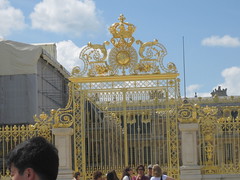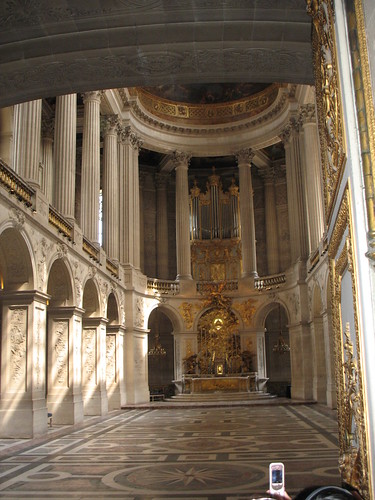This is a picture of the golden gates that stand just outside the palace complex.

You stand here for the line to go through security, and it was a hot and glorious summer's day when we were there.

You can see the Royal Chapel before you actually have to produce a ticket. Check out the inlaid floor!
Lesson number one? BRING WATER. You are allowed to bring a half liter of water in a clear container, and you will want it, because there is literally nowhere to get any water once you are inside--unless you are willing to trek way out of your way, and who wants to do that?
The ticket we had entitled us to enter the palace, the gardens, the Grand Trianon and the Petite Trianon. As it was Saturday, we were also eligible to see "Les Grandes Eaux Musicales." That is when they actually run the fountains, plus play period appropriate music. Due to problems with water pressure, the fountains don't actually run all the time--which we hardly noticed, as there is so much else to see.
We had passes to see the exhibition that was running at the time, on the tradition of grand court dressing, as well as special tickets to see the State Apartments at sunset, after the museum closed. So what did we do first? Went to see the State Apartments.
Well, we didn't know what to expect, and we kind of got there by mistake. While we were waiting for Cris to come back with audio guides, the girls went into some rooms that promised to put Versailles into historic context. Cris thought that was a good idea as a starting point, but it turned out there was really no exit. Once in the course of the State Apartments, there was no good way to swim upstream and get out, so we went through instead.
It was not necessarily a bad thing, as it turns out. The State Apartments comprise room after room of fantastic and ornate decoration, one room debouching into the next moving from tributes to Hercules, Mars, Apollo, each room swimming in elaborate touches. Surely the next room simply can't be as elaborate as this one--but then, it is. All the different marbles on the walls, woods on the floors, plaster curlicues on the ceilings are enough to overload the eyes, but then it is all painted! And gilded! If there is any question about whether less is more. . .add more!
Really, it's overwhelming. The sheer exuberance of the decor is enough to make one tired and docile, as well as making one feel seriously underdressed.

When confronted with the roccoco nonsense that is the Hercules Ballroom (named for the figure above, centered on the massive fireplace), one feels that a three foot tall wig and five foot wide panniers are necessary just to avoid getting lost against the walls.

Sitting beneath the enormous painting (a gift from someone, and the reason the ballroom was built). You can see three different types of marble, as well as large swathes of gilded woodwork on the walls, and the parquet floor.

The Hercules Ballroom, looking toward the Heracles fireplace. It's a bit daunting, as we are realizing that our entire house would fit in this single room.
The King's Rooms take the entire south wing of Versaille--full of enormous paintings, elaborate fireplaces, marble busts of anonymous Romans, like this one:

Each room has several French doors that open out onto elegant gardens and parterres.

At the end of the King's Rooms is a small (relatively) parlor room that opens onto the famous Hall of Mirrors. There is a reason this is famous: it is astonishingly beautiful, even in a world where mirrors are NOT as expensive as diamonds.

Again, just try to get a sense of how large this place is, and just how over the top. Even the ceiling is painted.

Gilded lamp posts holding crystal sconces.

Dozens of crystal chandeliers as well. Not to mention the larger than life sized marble statues representing the Greek gods.
The scale is almost impossible to imagine.

(This is from the evening tour--after 6:30, which was definitely worth it, because we got to see the rooms with fewer people in the dramatic light of the setting sun.)

View from the east "Peace" parlor, marking the beginning of the Queen's Rooms.

The canopy has to be twenty feet up in the air--Marie-Antoinette must have felt like a doll in that giant bed.

(edit by Mickey and Hannah, because we can even attack blog posts: A clock, so I always know what time it is...)
Even the mirrors in the Queen's Bedroom are decorated, and you can see the walls, ceiling, and the edge of the canopy as well.
While Marie-Antoinette is inextricably connected to Versailles, it is worth remembering that she had nothing at all to do with its construction or decoration. Built by Louis XIV, she was six generations away from him and merely inherited the "Queen's Rooms" when her husband became Louis XVI. The palace was already over 100 years old before she became Queen.
I found myself feeling sympathy for poor Marie-Antoinette--married to a man she had never seen at 14, shipped off to France and expected to live her life entirely in public--all because her five times great-grandfather-in-law had liked to live that way and had set his preferences into the concrete of protocol.
I mean, look at the level of decor in these rooms, which even when empty are a form of visual assault. Add furniture, hundreds of people, the sounds of their talk, the smells of bodies and perfume, the weight of being disliked for being Austrian--no wonder she felt the need to get away. To Petit Trianon, which is worth its own post.

No comments:
Post a Comment